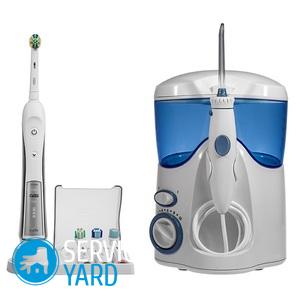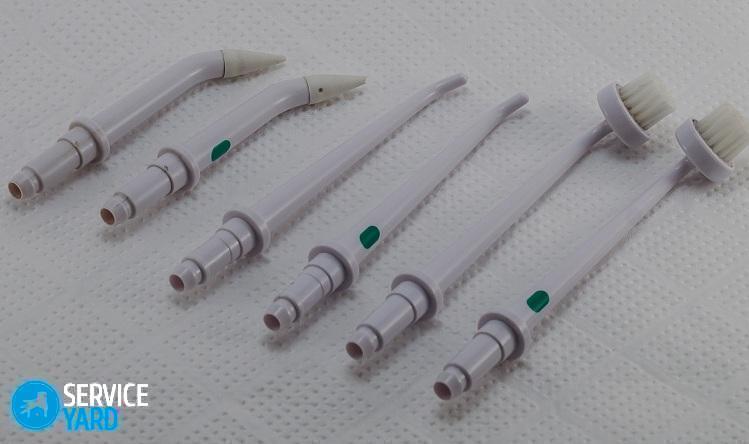How to use an irrigator?

Human health is determined by the proper functioning of each of the body systems. Therefore, sufficient attention should be paid not only to the liver, heart, but also to the oral cavity. According to the results of recent studies, it was found that using an ordinary toothbrush, one cannot guarantee one hundred percent health of teeth, gums, and also high protection against the occurrence of serious diseases of the oral cavity.
Companies that work in the pharmaceutical market are well aware of this and are actively working on creating new effective devices that can help maintain oral hygiene at the highest level. Of the latest innovations presented, it is worth highlighting the irrigator. In this article we will tell you how to use an irrigator so that your teeth always remain beautiful and healthy.
to contents ↑Appointment of an irrigator for the oral cavity
The main purpose of this device is professional dental care. This tool works easily:
- It creates the pressure of a jet of water under pressure, which is previously poured into a special tank.
- When water enters the oral cavity, particles of food and plaque are removed from the teeth, as well as from the interdental space.
- Along with this, a stream of liquid cleanses the gums, providing a massage effect.
Important! The irrigator is significantly superior to other similar devices - in the process of cleaning the oral cavity, it gently affects the teeth and gums, so that the user can not worry about tooth enamel.
This device is very convenient to use, so even if orthodontic products (braces) are installed in your mouth, you can clean them directly.
to contents ↑How is the irrigator arranged?
This unit consists of:
- Water tanks;
- Hydraulic pump;
- Handles to which the tank and the hydraulic pump are attached;
- Replaceable nozzles.
When should I brush my teeth with an irrigator?
Dentists recommend that every patient get this device, because if you use the irrigator correctly, you can not only remove dental deposits from the most inaccessible places. If a special solution is poured into the liquid tank instead of water, then a therapeutic effect (anti-carious and anti-inflammatory) can be achieved.
And especially doctors recommend using an irrigator in the following cases:
- People who have a tendency to develop periodontitis and gingivitis;
- With crowded teeth;
- Which have bad breath;
- To orthodontic patients;
- Women during pregnancy;
- Patients with diabetes.
What types of irrigators exist?
Today there are two types of irrigators:
- Family - it differs in that it has a large water tank, it works from the mains, and all family members can use it. There are color codes on the nozzles that enable family members to use them without confusion.
- Road - runs only on battery power and has a small water tank.
Nozzles for irrigator
Depending on the model you purchased, the kit may include one or more nozzles.Some are considered universal and suitable for daily hygiene, while others are designed to clean certain areas of the oral cavity.
The latter include:
- Nozzles for cleaning the tongue from plaque and food debris, which contribute to the appearance of an unpleasant odor. Using this nozzle, you will provide fresh breath for the whole day.
- To keep freshness nozzles for cleaning periodontal pockets will help. You will protect yourself from cervical caries and bleeding gums.
- Special orthodontic nozzles are used in the presence of braces - so you can easily remove the plaque around the locks. The same applies when implants or crowns are installed. You can only use the irrigator after the wound has completely healed after their implantation.
- There are also nozzles for washing the nasopharynx. They will help relieve inflammation and normalize the condition of the nasal canal.
How to use an irrigator?
Given the fact that for most of our fellow citizens this device seems to be a fairly new invention, not everyone understands how to use it correctly.
In fact, the rules are quite simple, and usually there are no difficulties. Here, everything will depend on the goal for which you are going to use the irrigator. It can be simple cleaning, treatment, standard prophylaxis or denture care.
Important! You should consult your dentist in advance. Each of the separately considered cases involves a different cleaning method.
 If you need an irrigator as a means for prevention, then you should adhere to standard rules:
If you need an irrigator as a means for prevention, then you should adhere to standard rules:
- Use the device in accordance with the attached instructions;
- Pour into the device only approved liquid or water;
- The angle of the jet should be 90 degrees;
- The procedure must be carried out sequentially;
- The head should be located so that fluid from the oral cavity can freely flow out;
- It is advisable to process the gaps between the teeth a little longer;
- The device should not be used by preschool children.
Frequency of use
For preventive purposes, it is advisable to use the irrigator no more than 3 times a week. The dentist can recommend the most optimal regimen and level of water supply for you. However, do not forget that the number of brushings with this device should not affect the number of standard toothbrushes with floss or toothbrush. The irrigator is just a supplement.
to contents ↑Important! In the early stages of caries or periodontitis, an irrigator should be used no more than twice a week.
Which liquid to use?
You can pour both ordinary warm water and decoctions of various medicinal herbs into the irrigator tank. However, with the latter you need to be extremely careful, because many phyto-collections have some contraindications. If there is a desire to use for this purpose decoctions of herbs, then at first it is better to consult a doctor.
Important! In addition to contraindications to the use of herbal decoctions in relation to health, small particles of plants can get into the technological parts of the irrigator, which can lead to disruptions in its operation, up to breakage. That is why, before applying, infusions must be carefully filtered several times.
The simplest and best solution is to use plain water. But before pouring water into the tank, it must be cleaned (filtered with a household filter), boiled and cooled to a temperature of 40 degrees.
It is important to understand that if you use too cold and not boiled water, this can lead not only to problems with the health of teeth and gums, but also reduce the life of the device itself.
If the factory instructions do not indicate that only clean water can be used as the liquid used, then several milliliters of tooth rinse can be added to the tank. Many dentists encourage this, as the rinse gives the gums and teeth additional protection from the effects of negative factors and prevents the appearance of coffee and tea plaque.
to contents ↑Important! If rinse aid is added to the device, then after use it should be thoroughly washed, as the product forms a plentiful foam.
Stock footage
That's all you need to know in order to use the irrigator correctly. For the rest, follow the instructions from the manufacturer of the particular model you have chosen, and then you can forget about possible problems with the teeth, gums and the oral cavity as a whole.
- How to choose a vacuum cleaner taking into account the characteristics of the house and coatings?
- What to look for when choosing a water delivery
- How to quickly create comfort at home - tips for housewives
- How to choose the perfect TV - useful tips
- What to look for when choosing blinds
- What should be running shoes?
- What useful things can you buy in a hardware store
- Iphone 11 pro max review
- Than iPhone is better than Android smartphones



